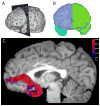Reduced structural connectivity of a major frontolimbic pathway in generalized anxiety disorder
- PMID: 22945621
- PMCID: PMC3566704
- DOI: 10.1001/archgenpsychiatry.2011.2178
Reduced structural connectivity of a major frontolimbic pathway in generalized anxiety disorder
Abstract
Context: Emotion regulation deficits figure prominently in generalized anxiety disorder (GAD) and in other anxiety and mood disorders. Research examining emotion regulation and top-down modulation has implicated reduced coupling of the amygdala with prefrontal cortex and anterior cingulate cortex, suggesting altered frontolimbic white matter connectivity in GAD.
Objectives: To investigate structural connectivity between ventral prefrontal cortex or anterior cingulate cortex areas and the amygdala in GAD and to assess associations with functional connectivity between those areas.
Design: Participants underwent diffusion-tensor imaging and functional magnetic resonance imaging.
Setting: University magnetic resonance imaging facility.
Participants: Forty-nine patients with GAD and 39 healthy volunteer control subjects, including a matched subset of 21 patients having GAD without comorbid Axis I diagnoses and 21 healthy volunteers matched for age, sex, and education.
Main outcome measures: The mean fractional anisotropy values in the left and right uncinate fasciculus, as measured by tract-based analysis for diffusion-tensor imaging data.
Results: Lower mean fractional anisotropy values in the bilateral uncinate fasciculus indicated reduced frontolimbic structural connectivity in patients with GAD. This reduction in uncinate fasciculus integrity was most pronounced for patients without comorbidity and was not observed in other white matter tracts. Across all participants, higher fractional anisotropy values were associated with more negative functional coupling between the pregenual anterior cingulate cortex and the amygdala during the anticipation of aversion.
Conclusions: Reduced structural connectivity of a major frontolimbic pathway suggests a neural basis for emotion regulation deficits in GAD. The functional significance of these structural differences is underscored by decreased functional connectivity between the anterior cingulate cortex and the amygdala in individuals with reduced structural integrity of the uncinate fasciculus.
Figures



References
-
- Kessler RC, Berglund P, Demler O, Jin R, Merikangas KR, Walters EE. Lifetime prevalence and age-of-onset distributions of DSM-IV disorders in the national comorbidity survey replication. Arch Gen Psychiatry. 2005;62:593–602. - PubMed
-
- Barlow DH. Anxiety and its Disorders. New York: Guilford Press; 2004.
-
- Barlow DH. Unraveling the mysteries of anxiety and its disorders from the perspective of emotion theory. Am Psychologist. 2000;55:1247–1263. - PubMed
-
- Borkovec TD, Alcaine O, Behar E. Avoidance theory of worry and generalized anxiety disorder. In: Heimberg RG, Turk CL, Mennin DS, editors. Generalized Anxiety Disorder: Advances in Research and Practice. New York: Guilford; 2004.
Publication types
MeSH terms
Grants and funding
- T32-MH018931/MH/NIMH NIH HHS/United States
- R25-GM083252/GM/NIGMS NIH HHS/United States
- R01 MH074847/MH/NIMH NIH HHS/United States
- T32 GM007507/GM/NIGMS NIH HHS/United States
- P30-HD03352/HD/NICHD NIH HHS/United States
- K02 MH082130/MH/NIMH NIH HHS/United States
- K02-MH082130/MH/NIMH NIH HHS/United States
- T32 MH018931/MH/NIMH NIH HHS/United States
- K08-MH63984/MH/NIMH NIH HHS/United States
- T32-GM007507/GM/NIGMS NIH HHS/United States
- K08 MH063984/MH/NIMH NIH HHS/United States
- P30 HD003352/HD/NICHD NIH HHS/United States
- P50 MH084051/MH/NIMH NIH HHS/United States
- R25 GM083252/GM/NIGMS NIH HHS/United States
- R01-MH74847/MH/NIMH NIH HHS/United States
- P50-MH84051/MH/NIMH NIH HHS/United States

